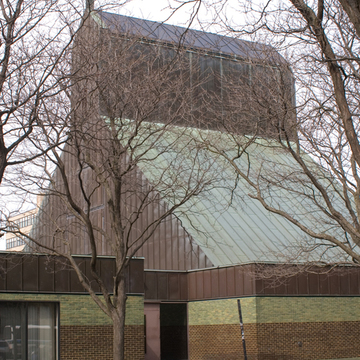In 1972 an arsonist destroyed the Gothic Revival Roman Catholic cathedral designed by Patrick C. Keely that had dominated the corner of St. Paul and Cherry streets since 1867. From a field of fifty-four architects, the diocese selected Barnes and his frequent collaborator, Vermont-based landscape architect Kiley, to design a replacement that eschewed the assertive monumentality of the lost building in favor of greenery and retreat. A Corten steel tower carrying a bell salvaged from the ruins marks the church's original location, but the new building is set back in the center of its block, surrounded by lawns and a grove of one hundred and twenty-three locust trees. Small in scale, it is nonetheless a significant presence, borrowing the rounded arches and rich colorism of H. H. Richardson's Billings Library (CH19.2). It consists of a pentagonal pavilion with a copper-sheathed sheltering roof that rests on a low, arcaded wall of green and brown glazed brick. The low western vestibule flanked by meeting rooms and offices opens into a dramatic, white, tentlike sanctuary with semicircular seating illuminated by a skylight sixty feet above its central aisle. A blue glass Jerusalem Cross window by Robert Sowers is installed above the vestibule, and arcs of stained glass are set into the deeply splayed embrasures of the low perimeter wall. The floor and altar are green slate and the pews and the freestanding reredos that divides the main sanctuary from an eastern chapel are made of white oak.
By 2018, the congregation had dwindled and the church was closed. It has been vacant ever since and is scheduled for demolition in 2023.


